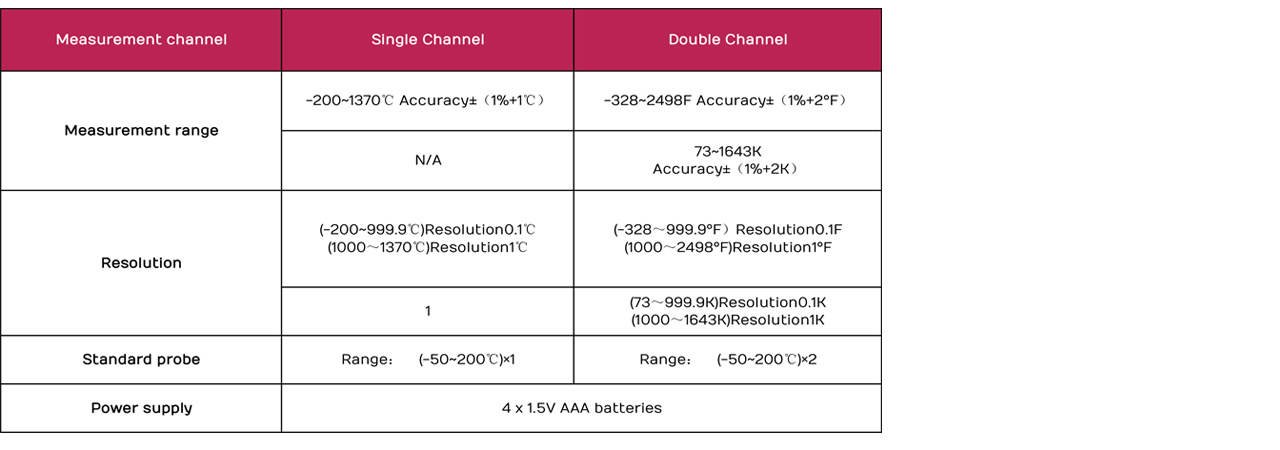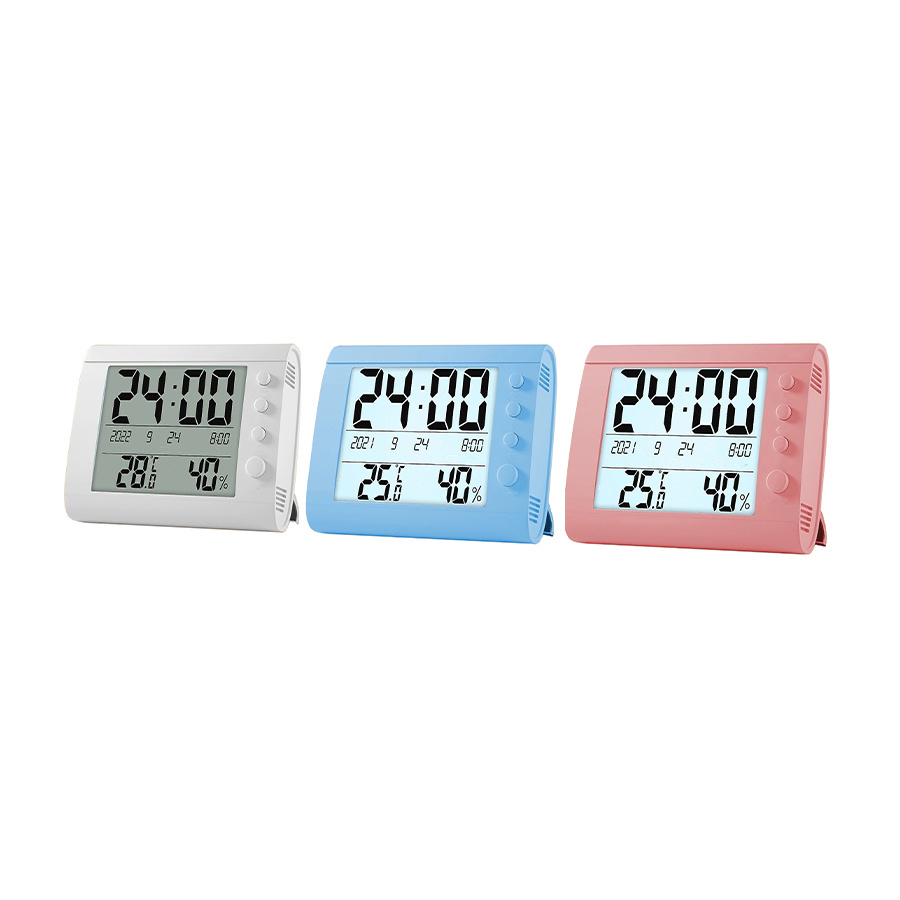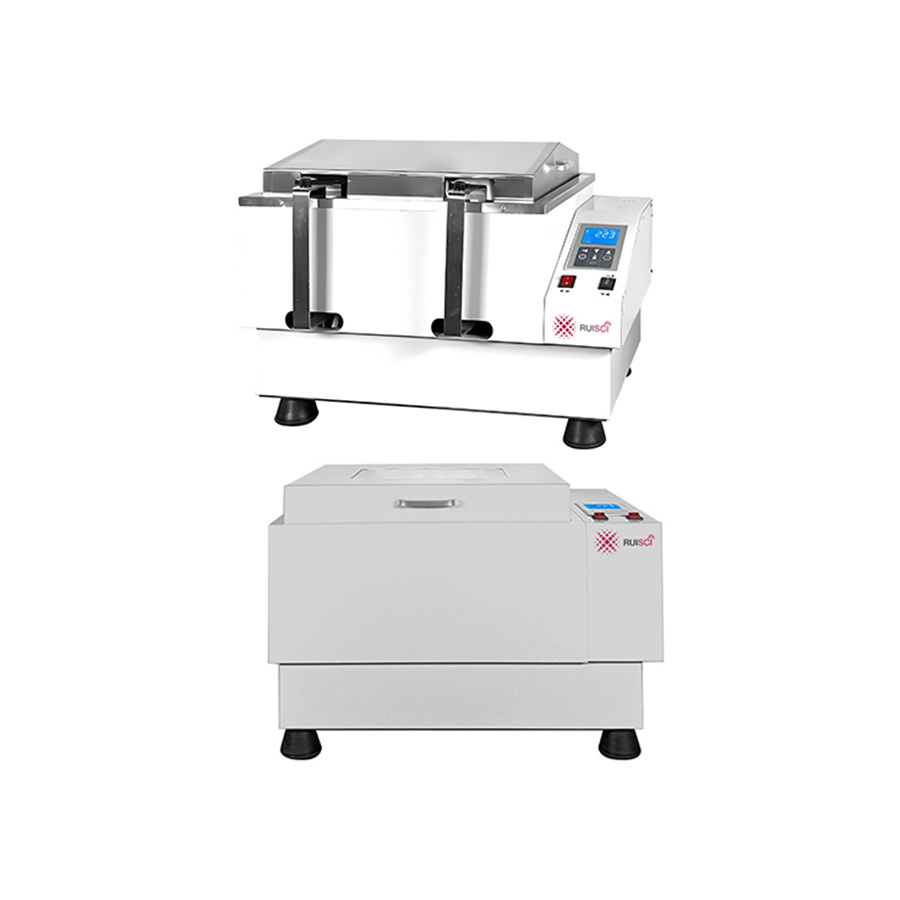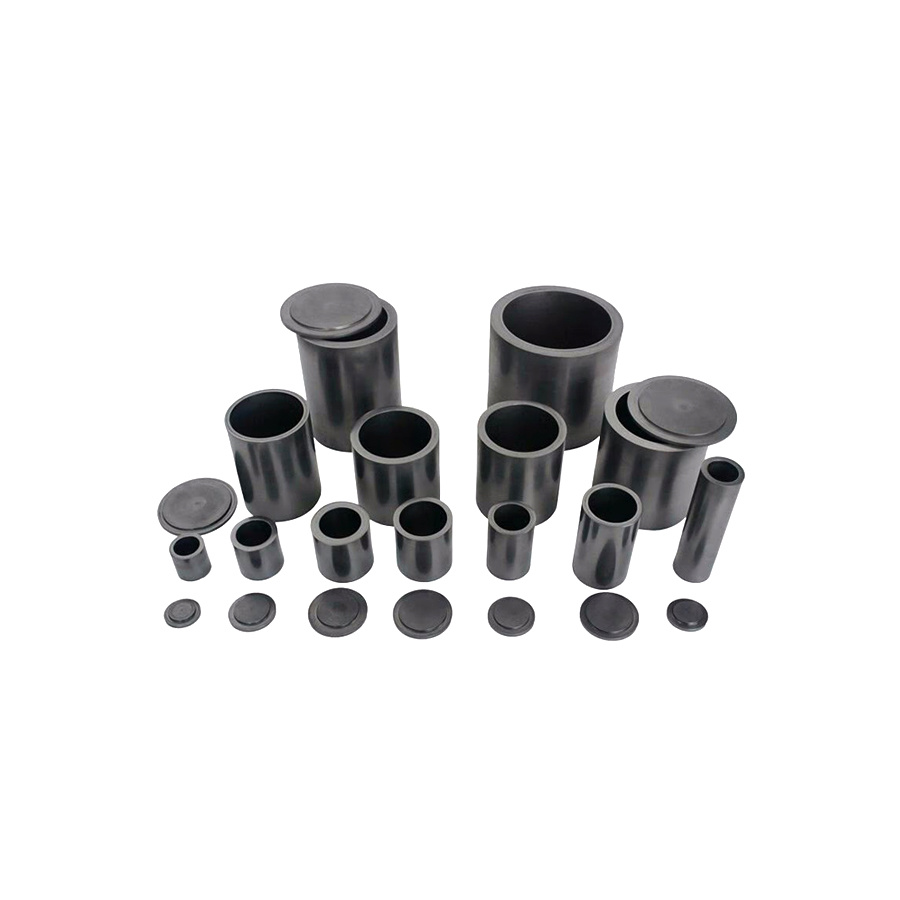Quality Assured
Just Buy It
- Comparison
- 在线预约
- 预约申请
- 样品申请
- 在线询价
Electronic Thermometer
Electronic Thermometer
DT-D,PP-A,PP-B,PP-C,PP-D,PP-E,PP-H

Brand:
RUISCI
-
Click to select
- DT-D-1,Single Channel
- DT-D-2,Double Channel
- PP-A-200,Square
- PP-B-200,Round
- PP-C-260,Probe Rod,-50~260℃
- PP-C-500,Probe Rod,-50~500℃
- PP-D-01,Short
- PP-D-02,Long
- PP-D-03,Angled
- PP-D-04,Roller
- PP-E-01,Steel and Aluminum
- PP-F-05,0.5m,0~1100℃
- PP-F-15,1.5m,0~1100℃
- PP-F-20,2m,0~1100℃
- PP-F-30,3m,0~1100℃
- PP-G-05,0.5m,0~1300℃
- PP-G-15,1.5m,0~1300℃
- PP-G-20,2m,0~1300℃
- PP-G-30,3m,0~1300℃
- PP-G-50,5m,0~1300℃
Inventory
5360
隐藏域元素占位
Overview
An electronic thermometer is a device that measures temperature using electronic components. It typically consists of a temperature sensor, a signal conversion circuit, and a display unit. The sensor converts temperature changes into electrical signals, which are processed by the circuit and presented as digital values on the display screen. It features intuitive readings, fast response, high accuracy, portability, and ease of use. It is widely used in laboratories, industries, and other fields to measure environmental temperature, surface temperature of objects, and various other scenarios.
Features
1. High-Precision Measurement: The high-precision K-type thermocouple temperature sensor is capable of accurately detecting temperature variations and providing precise temperature readings.
2. Swift Response Time: Owing to the rapid reaction characteristics of electronic components, the electronic thermometer can promptly sense temperature changes and display the results instantaneously.
3. Intuitive Digital Display: Through a high-definition display screen, the temperature value is presented visually in digital form, facilitating rapid reading and comprehension for users.
4. Portable and User-Friendly: The design is compact and lightweight, facilitating portability and operation.
5. Durable and Stable: With durable materials and a well-structured design, it can operate stably within a certain temperature range and environment, featuring a long service life and high reliability.
6. Multi-Functional: It is endowed with multiple functions, such as configurable automatic shutdown, temperature alarm, automatic calibration, data recording, and temperature unit switching.
7. Multi-Scenario Application: Different types of K-type thermocouple temperature probes are available for option to meet the requirements of various scenarios.
Technical data



Usage Precautions:
1. Confirm the measurement range and accuracy: Before use, make sure to confirm the measurement range and accuracy of the electronic thermometer to ensure it is suitable for the temperature range to be measured and to avoid damage to the device or inaccurate data due to exceeding the measurement range.
2. Ensure good contact of the probe: The contact between the probe and the object being measured must be sufficient and stable to ensure continuous heat conduction and measurement accuracy. For insertable probes, the insertion depth should be moderate, avoiding being too deep or too shallow.
3. Avoid electromagnetic interference: The signal transmission of electronic thermometers is susceptible to electromagnetic interference. Therefore, avoid using them in strong electromagnetic fields to prevent measurement errors.
4. Keep the device clean and dry: Regularly clean the exterior and probe of the thermometer with a soft cloth or a dedicated cleaner to prevent dust, oil stains, and other impurities from adhering, which could affect the performance of the sensor and the device's heat dissipation.
5. Read data correctly: When reading the temperature value, ensure that the viewing angle of the display and the lighting conditions are appropriate to avoid reading errors due to reflection or glare. Also, confirm that the temperature unit is set correctly.
6. Regular calibration and maintenance: To ensure measurement accuracy, it is recommended to calibrate the electronic thermometer regularly, at least once a year. Additionally, regularly check the battery level and replace the battery in a timely manner when the power is low.
The usage method of the magnetic contact probe is as follows:
1. Preparation: Ensure that the probe's appearance is intact, the leads are undamaged, and the insulation layer is in good condition.
2. Select Position: Choose a suitable measurement point on the surface of the object to be measured.
3. Fix the Thermocouple: Press the magnetic end of the probe tightly against the metal surface to ensure it is securely fixed by magnetic force.
4. Connect the instrument: Attach the leads to the temperature measurement instrument or control system.
5. Turn on the instrument: Start the instrument and begin the measurement.
6. Check the connection: Ensure the connection is secure to avoid poor contact.
7. Protective measures: If necessary, install a pressure-resistant jacket to protect the thermocouple.
8. Maintenance: Regularly clean the joints, avoid damp environments, and prevent oxidation and corrosion.
The usage method of the immersion probe is as follows:
1. Preparation: Ensure the probe is clean, undamaged, and the lead wire is intact.
2. Select the position: Determine the measurement point and ensure the probe can be fully immersed in the medium.
3. Fix the probe: Use a fixture or tape to fix the probe as needed to prevent movement.
4. Connect the instrument: Connect the probe lead wire to the temperature measurement instrument.
5. Turn on the instrument: Start the instrument and begin the measurement.
6. Check the reading: Observe the instrument display and ensure the reading is stable.
7. Record the data: If necessary, record the measurement results.
8. Maintenance: Clean the probe after use and store it in a dry place.
9. Regular calibration: To ensure measurement accuracy, perform regular calibration.
The usage method of surface contact probes is as follows:
1. Preparation: Inspect the probe to ensure it is clean and functioning properly.
2. Select the measurement point: Determine the surface location where the temperature needs to be measured.
3. Secure the probe: Press the probe firmly against the measurement surface to ensure good contact.
4. Connect the instrument: Attach the probe's lead to the temperature measurement device.
5. Start the equipment: Turn on the measurement device and begin recording the temperature. 6. Check the reading: Wait for the reading to stabilize, then record or monitor the temperature.
7. Maintenance: Clean the probe after use and store it in a dry environment.
8. Safety precautions: Avoid using in high-temperature or flammable environments.
keyword:
Thermohygrometer
Electronic Thermometer
Previous:
Next:
- 产品描述
- 概要参数
- 技术参数
-
- Brand: RUISCI
- Commodity name: Electronic Thermometer
- Subtitle: Electronic Thermometer
- Model: DT-D,PP-A,PP-B,PP-C,PP-D,PP-E,PP-H
- 全部型号: DT-D-1,DT-D-2,PP-A-200,PP-B-200,PP-C-260,PP-C-500,PP-D-01,PP-D-02,PP-D-03,PP-D-04,PP-E-01,PP-F-05,PP-F-15,PP-F-20,PP-F-30,PP-G-05,PP-G-15,PP-G-20,PP-G-30,PP-G-50,Thermohygrometer
An electronic thermometer is a device that measures temperature using electronic components.
An electronic thermometer is a device that measures temperature using electronic components. It typically consists of a temperature sensor, a signal conversion circuit, and a display unit. The sensor converts temperature changes into electrical signals, which are processed by the circuit and presented as digital values on the display screen. It features intuitive readings, fast response, high accuracy, portability, and ease of use. It is widely used in laboratories, industries, and other fields to measure environmental temperature, surface temperature of objects, and various other scenarios.
-
1. High-Precision Measurement: The high-precision K-type thermocouple temperature sensor is capable of accurately detecting temperature variations and providing precise temperature readings.
2. Swift Response Time: Owing to the rapid reaction characteristics of electronic components, the electronic thermometer can promptly sense temperature changes and display the results instantaneously.
3. Intuitive Digital Display: Through a high-definition display screen, the temperature value is presented visually in digital form, facilitating rapid reading and comprehension for users.
4. Portable and User-Friendly: The design is compact and lightweight, facilitating portability and operation.
5. Durable and Stable: With durable materials and a well-structured design, it can operate stably within a certain temperature range and environment, featuring a long service life and high reliability.
6. Multi-Functional: It is endowed with multiple functions, such as configurable automatic shutdown, temperature alarm, automatic calibration, data recording, and temperature unit switching.
7. Multi-Scenario Application: Different types of K-type thermocouple temperature probes are available for option to meet the requirements of various scenarios. -



Usage Precautions:
1. Confirm the measurement range and accuracy: Before use, make sure to confirm the measurement range and accuracy of the electronic thermometer to ensure it is suitable for the temperature range to be measured and to avoid damage to the device or inaccurate data due to exceeding the measurement range.
2. Ensure good contact of the probe: The contact between the probe and the object being measured must be sufficient and stable to ensure continuous heat conduction and measurement accuracy. For insertable probes, the insertion depth should be moderate, avoiding being too deep or too shallow.
3. Avoid electromagnetic interference: The signal transmission of electronic thermometers is susceptible to electromagnetic interference. Therefore, avoid using them in strong electromagnetic fields to prevent measurement errors.
4. Keep the device clean and dry: Regularly clean the exterior and probe of the thermometer with a soft cloth or a dedicated cleaner to prevent dust, oil stains, and other impurities from adhering, which could affect the performance of the sensor and the device's heat dissipation.
5. Read data correctly: When reading the temperature value, ensure that the viewing angle of the display and the lighting conditions are appropriate to avoid reading errors due to reflection or glare. Also, confirm that the temperature unit is set correctly.
6. Regular calibration and maintenance: To ensure measurement accuracy, it is recommended to calibrate the electronic thermometer regularly, at least once a year. Additionally, regularly check the battery level and replace the battery in a timely manner when the power is low.The usage method of the magnetic contact probe is as follows:
1. Preparation: Ensure that the probe's appearance is intact, the leads are undamaged, and the insulation layer is in good condition.
2. Select Position: Choose a suitable measurement point on the surface of the object to be measured.
3. Fix the Thermocouple: Press the magnetic end of the probe tightly against the metal surface to ensure it is securely fixed by magnetic force.
4. Connect the instrument: Attach the leads to the temperature measurement instrument or control system.
5. Turn on the instrument: Start the instrument and begin the measurement.
6. Check the connection: Ensure the connection is secure to avoid poor contact.
7. Protective measures: If necessary, install a pressure-resistant jacket to protect the thermocouple.
8. Maintenance: Regularly clean the joints, avoid damp environments, and prevent oxidation and corrosion.The usage method of the immersion probe is as follows:
1. Preparation: Ensure the probe is clean, undamaged, and the lead wire is intact.
2. Select the position: Determine the measurement point and ensure the probe can be fully immersed in the medium.
3. Fix the probe: Use a fixture or tape to fix the probe as needed to prevent movement.
4. Connect the instrument: Connect the probe lead wire to the temperature measurement instrument.
5. Turn on the instrument: Start the instrument and begin the measurement.
6. Check the reading: Observe the instrument display and ensure the reading is stable.
7. Record the data: If necessary, record the measurement results.
8. Maintenance: Clean the probe after use and store it in a dry place.
9. Regular calibration: To ensure measurement accuracy, perform regular calibration.The usage method of surface contact probes is as follows:
1. Preparation: Inspect the probe to ensure it is clean and functioning properly.
2. Select the measurement point: Determine the surface location where the temperature needs to be measured.
3. Secure the probe: Press the probe firmly against the measurement surface to ensure good contact.
4. Connect the instrument: Attach the probe's lead to the temperature measurement device.
5. Start the equipment: Turn on the measurement device and begin recording the temperature. 6. Check the reading: Wait for the reading to stabilize, then record or monitor the temperature.
7. Maintenance: Clean the probe after use and store it in a dry environment.
8. Safety precautions: Avoid using in high-temperature or flammable environments.
Q and A
Q
Distribution Modes:
A
Default Distribution Mode: EXW China Factory: After your payment is received, our customer service will contact you to confirm the pickup time and location once the goods are ready at the RUISCI China factory.
*Other options:
1.Carriage Paid To (CPT)
DO NOT PAY until you have contacted customer service to add shipping costs, as the default price is EXW China factory.
2.Delivered Duty Paid(DDP)
DO NOT PAY until you have ·contacted customer service to add Freight, insurance, taxes, customs clearance fees, and other miscellaneous expenses, as the default price is EXW China factory. Typically applies exclusively to small air cargo packages.
3. FOB China main port
DO NOT PAY until you have contacted customer service to add the inland charges and export declaration charges, as the default price is EXW China factory.
*** If you still need to consult other distribution modes or trade terms, please contact our customer service directly
Q
Payment methods:
A
1. On-line payment: Paypal
2. Off-line payment: Telegraphic Transfer (TT)
*All charges, except those incurred within our bank, are to be borne by the remitter. Insufficient payment will delay your shipment.
Download
There is currently no content to display
Related products
Online consultation








